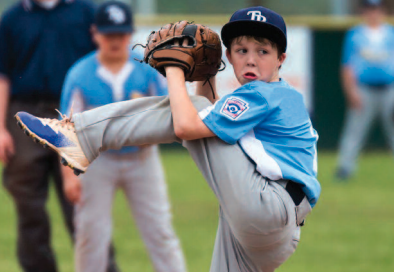
It can be a challenge to teach a youth pitcher to be competitive – challenging hitters, thriving when we need that last out, and being able to close the deal when there are two strikes on a batter. A simple speech is not going to give a pitcher these qualities, they can and must be emphasized and rewarded during practice. Here are a few drills that can be used to help develop competitiveness within your practices:
Knockout Drills build accuracy and competitiveness. Use a target as simple as a hula hoop hanging on a fence or net. Have a pitcher execute a pitch from flat ground or the mound within the hula hoop (or something smaller if you have higher level pitchers). If they do, they stay in. If they fail then they are knocked out if/when the next pitcher executes the pitch. You can also add an element of difficulty by trying to knock a ball off a batting tee.
You can also use a catcher for these drills, or have pitchers call pitches themselves, which can bring in elements of strategy. Eventually pitchers get a sense of each other’s weaknesses and take advantage of them to “win” the drill.
Three-Pitch Games require a pitcher and a batter, who is trying to get a hit off the pitcher in three pitches (or less). You can change scoring systems within a drill like this, but its purpose is to train pitchers to understand that every pitch counts, and forcing early contact is generally a good thing. This can also help with pressure situations/pitches when it comes down to the third and final pitch of an at-bat.
Pickoff Drills can be practiced every day. I want my pitchers to be very comfortable with picks, and I want our base runners to be able to identify and get good jumps against them. Organizing these drills within practice allows us to work “both sides of the ball” with pitching and base running.
Pickoffs have been a real success for us, and we’ve averaged about one out per game in the past few seasons on pickoffs alone. It may not sound like a lot, but the presence of that possibility can limit an opponent’s aggressiveness and change how they execute base running.
The performance of a pitcher has an impact on a game far beyond hits, balls, and strikes. If the team’s pitchers struggle, it impacts the entire game in a big way. Developing competitiveness with youth pitchers can be done within team practice through drills similar to these. When you have time, you can also individualize practice.
First, we have pitcher/catcher-only practices. This is mainly a preseason thing, but we keep it going as long as we can during the season. We call this “
Pitchers Camp.” This is where a lot of our pitcher/catcher rapport is built. We teach pitches, focus on mental skills, work on picks, and address situational baseball with our pitchers and catchers.
We also try to have our pitchers and catchers start their work early on most practice days. This obviously allots time for pitchers and catchers to work on position-specific items, but we can begin practice with those guys warmed up and loose, which is also beneficial if we have bullpens, bunt defense, or catchers throwing to bases that day. The realization that your players are getting extra work and coaching that other teams have not presents another opportunity to develop competitiveness and confidence.
As often as we can, we put pitchers in
competitive situations in practices so that they learn to be comfortable. We will have pitchers throw batting practice, sometimes everything down the middle, sometimes trying to get an out on every pitch. This gets very competitive during practice, as catchers jump in and learn to call the game and our players are able to learn how to read the batter, call pitches, and set up a hitter. It can also present opportunities to work on situational hitting (and therefore, pitching). We limit pitch counts or start with a fixed count to limit workload and force action.
When we scrimmage, everything comes together, ideally. In this environment, we’re not coaching skills as much as situations and attitude. We encourage our pitchers to pitch aggressively and to approach pickoff attempts like they would in a game.
As coaches know, some players are able to handle competitive situations better than others. Being intentional about creating these situations in practices and scrimmages can help players (and their coaches!) evaluate their individual level of competitiveness and hopefully make improvements with it!